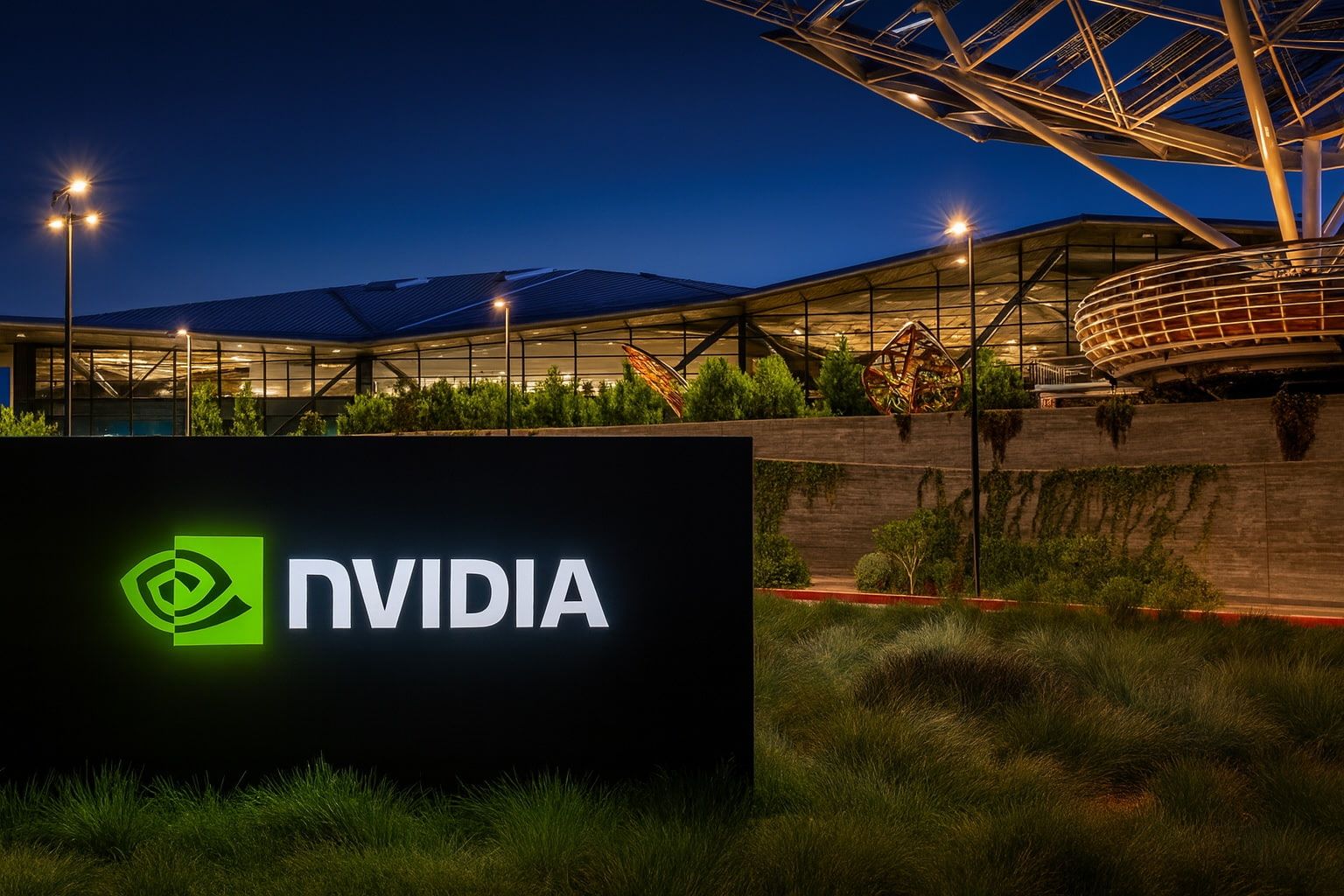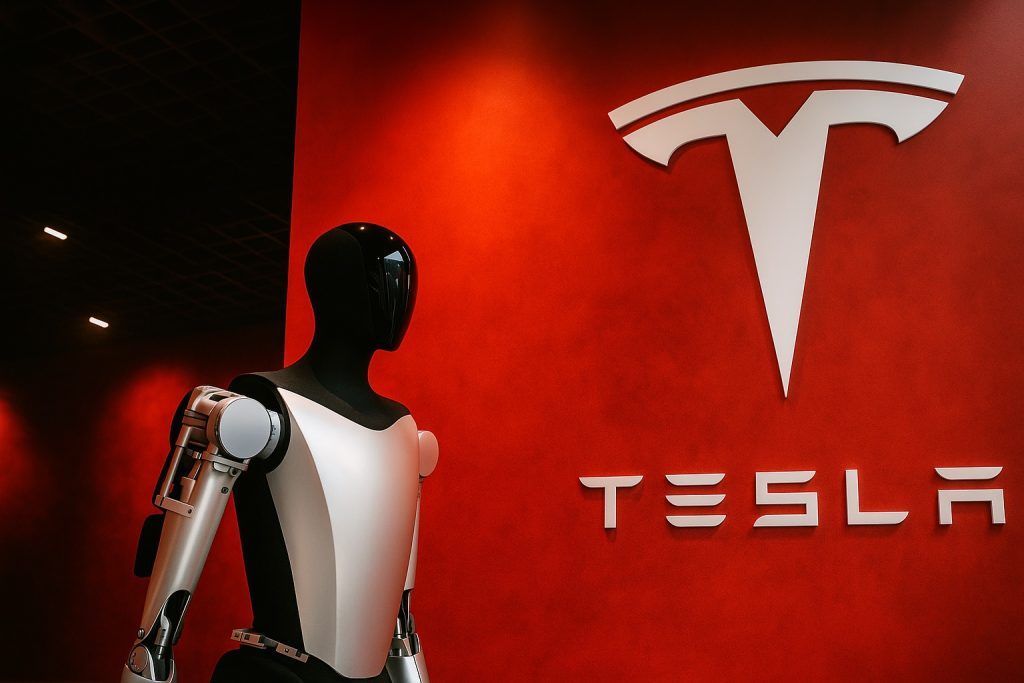Disclaimer: This article is for informational and educational purposes only and is not financial advice. Always do your own research and consider speaking with a licensed financial adviser before making investment decisions.
1. Where Nvidia Stock Stands in Late 2025
As of 22 November 2025, Nvidia (NASDAQ: NVDA) is still the central hardware winner of the global AI boom:
- Share price: Trading in roughly the high‑$170s to low‑$180s per share. [1]
- Market cap: Around $4.3–$4.4 trillion, making Nvidia one of the most valuable companies in the world. [2]
- Recent peak: On 29 October 2025, Nvidia briefly became the first company to hit a $5 trillion valuation, with shares around $209.40. [3]
- 52‑week high: About $212.19, with an all‑time closing high near $207.04. [4]
- 12‑month performance: The stock is up roughly mid‑20s percent over the past year. [5]
- Valuation: Trailing P/E in the mid‑40s, with forward P/E in the mid‑20s range according to major data providers. [6]
In short: Nvidia is no longer a “high‑growth mid‑cap” — it’s a mega‑cap behemoth priced as a premium growth stock, with expectations to match.
2. Earnings Momentum: AI Data Centers Still in Overdrive
Nvidia’s 2025 financial story is almost entirely about AI data centers.
Q2 FY2026 (reported August 2025)
For the quarter ended 27 July 2025, Nvidia reported: [7]
- Revenue: $46.7 billion (up 56% year‑over‑year and 6% quarter‑over‑quarter)
- Blackwell Data Center revenue: up 17% sequentially
- Zero sales of H20 AI chips to China, but a boost from selling previously reserved H20 inventory and redirecting chips to non‑China customers
Q3 FY2026 (reported November 2025)
For the quarter ended 26 October 2025, Nvidia delivered yet another blockbuster: [8]
- Revenue: about $57 billion, up 22% from Q2 and 62% from a year ago
- Data center revenue: ~$51.2 billion, up 25% sequentially and 66% year‑over‑year
- Net income: around $31.9 billion, with gross margin guided to the mid‑70% range
- Q4 revenue guidance: about $65 billion, well above Wall Street estimates
CEO Jensen Huang has repeatedly pushed back on “AI bubble” worries, arguing that demand for AI compute is still in an early innings of a major infrastructure build‑out. [9]
From a fundamentals perspective, Nvidia’s earnings growth has been extraordinary:
- Annual earnings growth of ~289% in FY2024
- ~131% growth in FY2025
- Consensus expectations for mid‑40% annual growth into FY2026–27 [10]
That combination — massive AI demand, triple‑digit earnings growth, and high margins — is what underpins today’s lofty valuation.
3. What Wall Street Expects From Nvidia into 2025
Across major analyst platforms, the picture is remarkably consistent: Nvidia remains a “Strong Buy” with significant upside, even after becoming a multi‑trillion‑dollar company.
Analyst price targets (12‑month horizon)
Recent aggregated forecasts show:
- StockAnalysis: 42 analysts, average price target $242.43 (≈36% upside), range $100–$352, consensus rating “Strong Buy.” [11]
- MarketBeat: 53 analysts, average target $257.79 (≈44% upside) from a current price near $179, range $205–$352. [12]
- TipRanks: 41 Wall Street analysts, average target ~$257, with a high near $352 and consensus “Strong Buy.” [13]
- Zacks: Short‑term targets from 43 analysts average roughly $240, with forecasts spanning $140–$350. [14]
- Benzinga (FactSet data): Consensus around $254.5, high $352 (Evercore ISI), low $165. [15]
In other words, most analysts see 35–45% potential upside over the next year based on current consensus, with the most aggressive targets calling for nearly double the current share price.
Some high‑profile calls include:
- Wedbush’s Dan Ives suggesting Nvidia could hit a $6 trillion market cap within 12–18 months. [16]
- HSBC and Melius Research issuing $320–$320+ price targets, implying 70–80% upside from recent levels. [17]
However, not everyone is all‑in. Some prominent investors, including Michael Burry, have taken large short positions against Nvidia, arguing AI names are overvalued and vulnerable to an AI‑bubble unwind. [18]
4. Big Forces That Could Move Nvidia Stock Before the End of 2025
4.1 AI Data Center Spending: The Core Growth Engine
The entire macro story for Nvidia comes down to whether the AI compute boom proves durable.
- Investment bank Barclays estimates that AI investments contributed about 1% to U.S. GDP growth in 2025, and that AI‑linked stocks have driven 75–80% of S&P 500 returns since late 2022. [19]
- Global AI spending is forecast to grow at roughly 37% CAGR through 2030, supporting Nvidia’s long‑term revenue targets. [20]
Nvidia’s own results back this up: the data center segment alone generated over $51 billion in Q3 revenue, with management guiding to even higher numbers next quarter. [21]
If hyperscalers (Microsoft, Amazon, Google, Meta, etc.) and large enterprises keep ramping GPU purchases at this pace, it is hard to argue the near‑term Nvidia story is broken. Any sign of a pause in AI capex — or a sharp pullback in spending — could quickly change that tone.
4.2 Product Pipeline: Blackwell, H200, and the Next Generations
Nvidia is executing an unusually rapid GPU upgrade cadence:
- The Blackwell architecture is now the flagship AI platform, driving record data center sales. [22]
- The successor “Rubin” platform and related products are already on the roadmap, promising yet another wave of performance and efficiency gains. [23]
- The company is expanding not only GPUs, but also networking (InfiniBand, Ethernet), CPUs, and full AI systems, capturing a larger share of each AI server’s bill of materials. [24]
The more Nvidia can lock in customers to a full‑stack platform (hardware, software, networking, tools), the stickier its revenue and the more defensible its margins.
4.3 Export Controls, China, and New Growth Regions
One of the biggest moving pieces for Nvidia in 2025 is U.S. export policy.
- CEO Jensen Huang has acknowledged that Nvidia’s market share in China dropped from about 95% to effectively 0 after tighter U.S. export controls on high‑end AI chips. [25]
- China now makes up only about 5% of Nvidia’s revenue, down sharply from earlier years, as H20 chip sales collapsed under new restrictions. [26]
- To offset this, Nvidia is leaning harder into new regions: the Middle East, particularly Saudi Arabia and the UAE, where U.S. authorities have authorized exports of up to 35,000 Blackwell AI chips, likely worth over $1 billion. [27]
- Reuters recently reported the U.S. is considering allowing Nvidia to sell its more advanced H200 chips to China, which would be a significant policy shift if approved. [28]
Compliance risk is real: U.S. prosecutors have already charged individuals in an alleged scheme to illegally export restricted Nvidia GPUs to China and Hong Kong, highlighting how sensitive these chips are. [29]
For Nvidia stock through the end of 2025, any surprise tightening or loosening of export rules — especially regarding China — could move the share price quickly.
4.4 AI Bubble Anxiety vs. Structural Growth
Global markets are openly debating whether we’re in an AI bubble:
- Some economists and academics note AI‑related valuations and capex are running far ahead of realized productivity gains, and that many enterprises are still not getting clear returns on generative AI investments. [30]
- Nvidia sits at the center of this debate: it became the first company ever to reach a $4 trillion valuation (and then $5 trillion) largely on AI expectations. [31]
- At the same time, many analysts argue Nvidia’s current numbers — huge profits and multi‑year visibility into AI demand — make it very different from classic bubbles driven purely by hope. [32]
For investors, this means sentiment can swing fast. Nvidia’s shares recently dropped multiple percentage points on renewed AI‑bubble headlines, even as average analyst targets moved higher. [33]
5. Is Nvidia Stock Overvalued in 2025?
There is no single “right” answer, but we can outline the main arguments on both sides.
The “Overvalued” view
Critics point to:
- High valuation multiples: A trailing P/E around 44 (or higher, depending on the data source) after an already massive run. [34]
- Trillion‑dollar expectations baked in: At a ~$4.4 trillion market cap, Nvidia needs to sustain very high growth rates for many years to justify the price. [35]
- AI bubble warnings: Investors like Michael Burry have specifically targeted Nvidia with large bearish bets, arguing AI valuations have detached from reality. [36]
- Intrinsic value models: Some discounted‑cash‑flow tools peg Nvidia’s fair value close to today’s price (for example, AlphaSpread’s base case intrinsic value around $177 per share, implying the stock is modestly overvalued by about 1%). [37]
The “Still Reasonable” view
Supporters counter with:
- Explosive earnings growth (triple‑digit in FY24–25, strong double‑digit projected for FY26–27). [38]
- Record profitability and margins, plus a commanding share of the AI GPU market (effectively a near‑monopoly at the high end). [39]
- A long runway for AI infrastructure spend: forecasts for AI market growth near 37% CAGR through 2030, and AI already driving a large share of market returns. [40]
The truth is likely somewhere in the middle: Nvidia is priced for excellence, not mediocrity. If it merely stays “good,” the stock could tread water or even correct; if it remains exceptional, today’s multiples may prove justified.
6. Nvidia Stock Forecast Scenarios Through the End of 2025
No one can predict stock prices with certainty, but we can outline plausible scenarios for where Nvidia might trade by 31 December 2025, using today’s fundamentals and market expectations as a guide.
To ground this, remember:
- Recent price: roughly $180 per share
- Trailing EPS: about $4.06, giving a P/E near 44 at recent levels [41]
- 12‑month analyst targets: roughly $240–$260 average, with a high around $350 [42]
6.1 Bull Case (roughly 25% probability)
Narrative: Nvidia remains the undisputed AI infrastructure king, and the market fully buys the story.
Possible ingredients:
- AI data center demand stays “off the charts,” and Q4 2025 results beat the already‑bullish $65B revenue guidance. [43]
- No major macro shock; AI‑related capex remains aggressive into early 2026.
- Export policy loosens at the margin (e.g., partial approval for H200 sales to China or additional Middle East deals), unlocking incremental demand. [44]
- The market decides AI is a long‑duration structural theme, not a bubble to be popped.
In this scenario, investors might be willing to pay a P/E in the 50–55x area on forward earnings. With current earnings power and growth, that would plausibly support a share price in the ~$210–$230 range by year‑end — roughly retesting or exceeding the 52‑week high.
That would represent ~15–30% upside from recent levels in just a few weeks, which would be aggressive but not unprecedented for a stock as volatile as Nvidia.
6.2 Base Case (roughly 50% probability)
Narrative: Fundamentals stay strong, but the market wrestles with AI‑bubble narratives and valuation.
Possible ingredients:
- Q4 results are solid and roughly in line with guidance — good, but not jaw‑dropping.
- AI capex continues, but at a slightly more measured pace as enterprises look for ROI. [45]
- Export policy noise continues, but without a major break in either direction.
- Interest rates stay stable enough that valuation multiples don’t collapse, but investor enthusiasm cools after the 2025 rally.
In this more moderate outcome, Nvidia’s P/E might hover in the 40–45x band. That would suggest a share price roughly in the $175–$200 range into year‑end 2025 — essentially around today’s level, plus or minus a mid‑teens move.
Under this base case, Nvidia would likely undergo digestion: earnings keep rising, but the share price trades sideways to modestly higher as the market waits to see how sustainable AI profits really are.
6.3 Bear Case (roughly 25% probability)
Narrative: Sentiment turns sharply, even though Nvidia’s underlying business stays strong.
Possible ingredients:
- A broader market correction tied to AI bubble fears, with investors rotating out of expensive growth stocks. [46]
- A temporary slowdown in AI GPU orders as hyperscalers optimize utilization or delay new projects.
- Negative headlines around export controls, regulatory scrutiny, or AI safety, raising risk premiums. [47]
- Short sellers and cautious voices (like Michael Burry) gain traction, reinforcing downside momentum. [48]
If investors demand a lower multiple — say 35–40x earnings — that would map to a share price in the $140–$160 areagiven current EPS. A 20–30% drop from current levels is entirely plausible for a stock with Nvidia’s volatility, even in the absence of a collapse in fundamentals.
7. How Nvidia Might Fit in a Portfolio (Through a 2025 Lens)
Again, this is not advice, but here’s how many investors think about a name like Nvidia:
- High‑conviction growth core: For investors convinced AI is the next multi‑decade platform shift and that Nvidia will remain its backbone, NVDA often becomes a core, but sized carefully because of volatility.
- AI “index proxy”: Some treat Nvidia as a liquid proxy for AI infrastructure. If AI capex booms, you expect Nvidia to benefit; if AI stalls, you expect Nvidia to get hit early.
- Risk‑managed position: Because the stock can swing 10–20% in short periods, many investors focus on position size, diversification, and time horizon, not precise short‑term price targets.
Key questions to ask yourself:
- Time horizon: Are you looking at 5–10 years of AI build‑out, or trying to guess the stock’s level by New Year’s Eve?
- Volatility tolerance: Could you stomach a 30–40% drawdown even if the long‑term story stays intact?
- Concentration risk: How large is your Nvidia exposure relative to your overall portfolio and to other AI or tech names?
8. FAQ: Nvidia Stock and 2025 Outlook
Q1: Is Nvidia stock a buy, hold, or sell going into 2026?
- Wall Street: The consensus rating is still firmly “Strong Buy”, with average 12‑month price targets in the mid‑$240s to mid‑$250s — 35–45% above current levels. [49]
- Skeptics: Highlight very high expectations, AI bubble warnings, and the risk that even small disappointments could trigger a big re‑rating. [50]
Whether it’s a buy, hold, or sell for you depends on your risk tolerance, portfolio, and time horizon — topics best discussed with a professional adviser.
Q2: Could Nvidia hit $300 or a $6 trillion market cap soon?
Some analysts do see that kind of upside:
- Melius Research and HSBC have targets around $320. [51]
- Wedbush’s Dan Ives has floated the idea of Nvidia reaching $6 trillion in market value within 12–18 months. [52]
For that to happen, Nvidia likely needs:
- Continued explosive AI demand
- No major policy shock on exports
- Market willingness to keep paying very high multiples for growth
It’s possible — but far from guaranteed — and would likely come with intense volatility.
Q3: What are the biggest near‑term catalysts before year‑end 2025?
Watch for:
- Q4 FY2026 earnings and any update to 2026 guidance
- New AI chip announcements or road‑map details beyond Rubin
- Policy moves around export controls to China or the Middle East
- Any shift in AI capex commentary from big cloud providers
- Macro data or regulatory actions that change the market’s view on an AI bubble
Bottom Line
Nvidia enters the final stretch of 2025 as:
- A $4+ trillion AI superpower
- A company posting record‑breaking revenues and profits driven by data center GPUs
- A stock with lofty expectations, caught between AI bubble anxiety and genuine structural growth
Between now and the end of 2025, Nvidia’s share price is likely to remain highly sensitive to:
- AI capex headlines
- Export control developments
- Broader risk sentiment toward expensive tech
For long‑term investors who believe AI is still in its early innings, Nvidia may remain a central way to express that view — but it’s a position where great potential and substantial risk sit side by side.
References
1. investor.nvidia.com, 2. www.macrotrends.net, 3. www.reuters.com, 4. www.macrotrends.net, 5. www.investing.com, 6. fullratio.com, 7. nvidianews.nvidia.com, 8. investor.nvidia.com, 9. www.ft.com, 10. finance.yahoo.com, 11. stockanalysis.com, 12. www.marketbeat.com, 13. www.tipranks.com, 14. www.zacks.com, 15. www.benzinga.com, 16. www.businessinsider.com, 17. www.barrons.com, 18. m.economictimes.com, 19. www.marketwatch.com, 20. finance.yahoo.com, 21. investor.nvidia.com, 22. investor.nvidia.com, 23. www.ft.com, 24. www.tomshardware.com, 25. www.wsj.com, 26. m.economictimes.com, 27. www.reuters.com, 28. www.reuters.com, 29. timesofindia.indiatimes.com, 30. en.wikipedia.org, 31. en.wikipedia.org, 32. www.ft.com, 33. www.barrons.com, 34. fullratio.com, 35. www.macrotrends.net, 36. m.economictimes.com, 37. www.alphaspread.com, 38. finance.yahoo.com, 39. investor.nvidia.com, 40. finance.yahoo.com, 41. fullratio.com, 42. stockanalysis.com, 43. investor.nvidia.com, 44. www.reuters.com, 45. en.wikipedia.org, 46. www.investing.com, 47. m.economictimes.com, 48. m.economictimes.com, 49. stockanalysis.com, 50. www.investing.com, 51. www.barrons.com, 52. www.businessinsider.com









